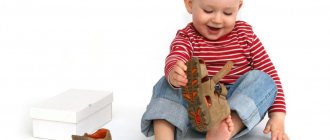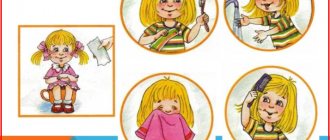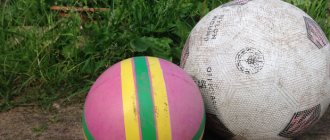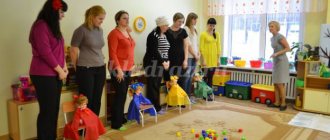MAGAZINE Preschooler.RF
Self-service in the second junior groupIn the 4th year of life, the child’s activity and purposefulness increase, and movements become more varied. Children begin to master the ability to act, setting a goal, but due to instability of attention, they are still quickly distracted and move from one thing to another.
In younger groups, the main task is to develop independence and a positive attitude towards work.
A three-year-old child has an inherent desire to act independently. “I myself!” - he declares, often not realizing his capabilities. Self-care occupies a large place in the work activities of children of the 4th year of life. When organizing the work of children, teaching them self-service skills, it is important not to suppress the desire for independence; this great “conquest” of a three-year-old child is the most important factor in the formation of his hard work. Great patience and pedagogical tact are required from the teacher, so as not only not to extinguish the children's initiative, but also to promote its development. Game techniques are of decisive importance, since they allow the teacher, on the one hand, to hide his pedagogical position, and on the other, to more actively influence the child. So, a teacher can bring a large doll into the group and say that she came to visit the kids by train and will live with them. Children get acquainted with the toy, assign it a closet, together with the teacher set up a crib in the bedroom, assign a place at the table in the doll's corner, etc. Then they teach the doll self-care skills.
A positive assessment by an adult of even small successes of a child causes satisfaction in the child and gives rise to confidence in his abilities. This is especially important to remember when communicating with shy and timid children. In relation to a spoiled child who has a tendency to be arrogant, encouragement should be used carefully.
An effective technique is to attract a positive reception (Look how Tanya dresses quickly and correctly!). You can get your child interested in self-care activities by arousing his interest in the subject. For example, while washing, the teacher gives the children a new soap in a beautiful wrapper, invites them to unwrap it, examine it, and says: “What a smooth soap, how good it smells! And how well this soap must foam! Let's try!"
Self-care skills in children are also developed in games with dolls, in the process of performing various actions (undressing, dressing, combing their hair, etc.), in didactic games like “The Bear is Frozen” ; “Doll Natasha came to kindergarten” , etc.
It is important to encourage children to help each other, using the example of those who have already developed certain skills, to teach them to be attentive and kind to each other. But this technique should be used carefully so that the child does not get used to constant help.
Sources used:
- Methodological recommendations for the “Program of education and training in kindergarten” by L. V. Russkova. - M.: Education, 1999.
- Bure R.S., Zagik L.V. et al. Education of preschool children at work. — 3rd ed., isp., additional. - M., 1983
- Ivashchenko F.I. Psychology of labor education. — Minsk, 1988
- Kaplan L.I. If you sow a habit, you reap a character. - M., 1980
- Nechaeva V.G. Raising a preschooler at work. - M., 1990
- Educational psychology / Ed. Klyuevoy N.V. - M., 2003
- Labor and observations in nature. - M., 1987
- Tsukerman G.A., Elizarov N.V. About children's independence //
| Next > |
Card index of games for developing self-service skills in the younger group
Natalia Yankova
Card index of games for developing self-service skills in the younger group
Goal: Creating conditions for the development of independence , focus, self-regulation of one’s own actions.
Tasks:
1. Continue teaching children independently in a certain sequence (putting on and taking off clothes, unbuttoning and fastening buttons, folding, hanging clothes, etc.).
2. Develop neatness, the ability to notice disorder in clothing and eliminate it with a little help from adults.
3. Continue to teach correctly, use soap, carefully wash your hands, face, ears, wipe yourself dry after washing, hang the towel back, use a comb, and a handkerchief.
4. Learn to use tablespoons, teaspoons, forks, and napkins correctly.
Didactic games
Hygiene rules"
Goal: creating conditions for consolidating cultural and hygienic skills (washing, dressing, brushing teeth, combing your hair, bathing, developing the ability to show these movements with the help of facial expressions and gestures and guess by showing them.
Procedure: the teacher asks the children, using facial expressions and gestures, to show how they wash themselves (dress, brush their teeth, etc., following the sequence of performing these skills . Or the teacher shows, using facial expressions and gestures, what he is doing, and the children guess.
"Pick a Pair"
Goal: creating conditions for the correlation of objects in the pictures with actions ; strengthening self-care skills .
Equipment: subject pictures : vacuum cleaner, comb, soap, toy cabinet; subject pictures : cleaning the apartment, boots, clothes, toys.
Progress: children carefully examine the pictures , compare them and select pairs, explaining their choice.
"What's first, what's next"
Goal: creating conditions for developing the ability to arrange pictures in order of plot development , using an auxiliary tool; write short stories.
Procedure: children are offered several pictures connected by one plot, arrange them in the order of the events that happened and compose a story based on them. For example: a boy lies in bed, does exercises, washes himself, wipes himself with a towel; girl washes her hands, has lunch, plays with a doll
"Hygiene rules"
.
Goal: to create conditions for clarifying children’s ideas about hygiene skills and forming the foundations of a healthy lifestyle.
Move: using a counting rhyme, the driver is selected, he leaves the group . The teacher and the children agree on who will portray what and what. Then the driver is invited, the children take turns demonstrating skills using gestures and facial expressions. The presenter must guess what the children are showing: washing, brushing teeth, combing their hair, bathing.
"Find a Pair"
Goal: to create conditions for the development of skills to distinguish between paired shoes and clothes.
Equipment: shoes cut out of cardboard : boots, shoes, gloves, socks, mittens, Masha doll.
Progress: the teacher introduces the children to a game situation: “Masha, the confused one, scattered her clothes and shoes in different corners. She can't find anything on her own. She found one sock, but can’t find the other, found one boot, but doesn’t know where the other one is, etc.” The children are invited to help Masha, who is at a loss, find a couple of items of clothing and shoes. The teacher presents the right version of the pair (sock, boot, etc.)
and offers to choose the left one. At the same time, the instruction is given:
. ”
“Let’s choose clothes for the dolls”
Goal: creating conditions for developing the ability to name items of clothing, differentiate clothes for boys and girls, and consistently dress a doll.
Equipment: two dolls - Mitya doll and Katya doll, sets of clothes for girl and boy dolls.
Proceedings Teacher: “Look, children, dolls came to visit us, but they can’t get dressed, they mixed up their clothes and can’t find their things. Let’s help them figure out where and whose things are.” The teacher asks: “What do girls wear and what do boys wear?”
After the children choose clothes for the dolls, one child begins to dress Mitya, and the other - Katya. At this time, the teacher focuses the children’s attention on the sequence of dressing. The teacher always praises the children for the fact that the dolls are dressed correctly and beautifully.
Game situations
"Let's teach a doll to wash its hands"
Goal: creating conditions for consolidating knowledge about personal hygiene items, sequence of actions, and developing the habit of neatness.
Equipment: personal hygiene items, dolls.
Procedure: children sit in front of a play corner, which contains a washbasin and a cabinet with a towel. The teacher brings the doll Anya with dirty hands. Doll Anya is going to visit and “changes clothes”
.
She “takes”
the dress
with “dirty hands”
and stains remain on the dress.
Seeing this, the Anya doll begins to cry. The teacher says: “Oh, the Anya doll took the dress with dirty hands! Children, what needs to be done? (children's answers)
Teacher: That's right, the doll needs to wash its hands. Don’t cry, Anya, we’ll wash your hands now.”
“Let’s give the dolls different hairstyles”
Goal: creating conditions for consolidating hair care skills , clarifying the names of the items necessary for this, and forming the concept of “neat”
appearance.
Equipment: dolls, combs, hairpins.
Procedure: the teacher invites the children to comb the dolls' hair.
"Tanya caught a cold"
Goal: creating conditions for the development of skills and the formation of the skill of using a handkerchief.
Equipment: handkerchief
Progress: the teacher asks: why do people need a handkerchief?
And then he offers the children various situations, which they play out together with the kids:
— What should you do if you want to sneeze? Etc.
“Let’s dress the doll for a walk”
Goal: to create conditions for developing children’s skills in dressing a doll according to the weather.
Equipment: paper doll with various clothes
Progress: the teacher says that the doll is going for a walk, but doesn’t know what to wear, it’s winter and it’s very cold outside (various situations)
.
Children "dress"
doll and explain their choice.
Exercise
"Soap Gloves"
Goal: to create conditions for the development of children’s ability to soap their hands well from the outside and inside until bubbles form.
Equipment: bathroom, baby soap, towel.
Progress: Teacher: “We’ll go to the sink, open the tap and let warm water in, and now we’ll take the soap and make ourselves beautiful “white gloves.” The teacher explains the process of soaping hands step by step. Children soap their hands without water until white foam forms, then the children put the soap in a soap dish and distribute the soap over their hands in a circular motion. The teacher draws the children’s attention to the fact that they have created fashionable “white gloves.” It is advisable to use various poems and nursery rhymes in your work. For example:
“Okay, okay, wash your little hands with soap, Clean palms, here’s bread and spoons for you! Water gurgles in the tap. Very cool!
Washes herself (child’s name)
»
"Our things go to bed"
Goal: to create conditions for the development of children’s ability to neatly put things on a high chair.
"We'll tuck in our jerseys."
Goal: to create conditions for the development of children’s ability to tuck in T-shirts and T-shirts.
We do everything in order"
Goal: to create conditions for the development of children’s ability to take off and put on clothes in a certain order.
"Turn out your tights"
Goal: to create conditions for the development of children’s ability to turn tights inside out correctly.
Card file of cultural and hygienic skills (junior group 2)
Card No. 1
"I myself."
Target:
consolidate the ability to eat carefully, take food only with a spoon, improve food culture skills; teach children to hold a spoon correctly, eat and drink food without spilling, and chew thoroughly.
Teach politely to express a request for help; strengthen the ability to independently remove shoes and clothes and put them in a closet.
Card No. 2
"Clean nose"
Target:
Encourage children to take care of their appearance, use a handkerchief in a timely manner, and cultivate neatness and independence.
Card No. 3
"Scented soap."
Goal: to encourage children to independently take soap from a soap dish, rub their palms, rinse off the soap, and know the location of their towel.
Card No. 4
"Dry sleeves."
Goal: to develop the ability to wash hands carefully, roll up sleeves, not spill water on the floor, and wipe them dry with a personal towel; develop the ability to wash your hands before eating, lather your hands well and thoroughly wash off the dirt.
Card No. 5
“We love to wash ourselves.”
Target:
to form cultural and hygienic skills in children, to promote the correct use of an individual towel, and to consolidate the ability to hang it in place.
Card No. 6
"Table manners"
Target:
to develop children’s cultural and hygienic self-service skills, to teach them to sit correctly at the table and use cutlery.
Card No. 7
"Dressing and undressing."
Goal: to consolidate the ability to unfasten and fasten Velcro fasteners, practice using other types of fasteners, continue to teach them to follow the rules of behavior in the locker room, and ask for help using polite words.
Card No. 8
“We wash our hands properly.”
Goal: to develop basic cultural and hygienic skills in children, to teach them to wash their hands correctly, thoroughly dry each finger, and hang a towel in its place.
Card No. 9
“Water, water.”
Target:
develop the ability to take soap from a soap dish, lather your hands until white foam, and wash off dirt well; develop independence and the ability to wash hands correctly and thoroughly.
Card No. 10
"We eat".
Target:
develop the ability to eat independently and neatly, sit calmly at the table, maintaining the correct posture, and teach to hold a spoon in the right hand.
Card No. 11
«Wash your hands with soap."
Target:
help children remember the sequence of proper washing: take soap, wet, soap your hands, lather until white foam, wash off dirt and soap, wash.
Card No. 12
“Where is my towel?”
Goal: to encourage children to find their own towel, thoroughly dry their face and hands, and hang it up; develop spatial orientation and attentiveness.
Card No. 13
"Shoes in place."
Target:
to develop self-care skills in children, to teach them to carefully place shoes near the crib, and to put on their shoes independently after sleep.
Card No. 14
«
Clean hands."
Goal: to strengthen the ability to wash hands correctly and carefully: lather thoroughly, rinse off the soap well; wipe dry with a towel; strengthen children's health, teach them to wash their hands correctly, tell them why it is important to wash your hands thoroughly after a walk, using the toilet, and before eating.
Card No. 15
“I’m learning to do everything myself!”
Goal: to continue to encourage children to dress and put on their own shoes, to be friendly to each other, and to develop communication skills.
Card No. 16
«Neat hairstyle».
Goal: to teach children to use an individual comb and control their appearance using a mirror.
Card No. 17
“Put on your pants, put on your feet!”
Goal: to encourage children to dress and put on their own shoes, to be friendly to each other, and to develop communication skills.
Card No. 18
“Put the chair back in place.”
Goal: to teach children to correctly pick up a chair and carefully put it in place; develop spatial orientation and coordination of movements.
Card No. 19
«Wash, wash your hands.”
Target:
teach children to roll up their sleeves before washing their hands and wash their face without splashing water.
Card No. 20
"Shoes."
Goal: to teach students to independently unfasten and fasten Velcro fasteners, and practice using other types of fasteners.
Card No. 21
“I’m already big!”
Target:
consolidate the ability to sit correctly at the table, eat carefully, take food only with a spoon, use a napkin; improve food culture skills.
Card No. 22
“Clean!”
Target:
to teach children to take care of their appearance, to play carefully with sand, not to take it with their hands, to put themselves in order in a timely manner, to cultivate neatness and independence.
Card No. 23
«
Where's my high chair?
"
Goal: to teach children to find their chair, to take it correctly and carefully place it near the table, to introduce children to the rules of safe behavior in a group.
Card No. 24
"Things in place."
Goal: to develop in children the ability to take clothes out of the locker and put them away after undressing, to fold everything carefully; to teach children to verbally express a request for help, to develop the ability to behave calmly in the dressing room.
Card No. 25
“This is what we are!”
Target:
to teach children to behave properly at the table, to eat carefully, not to disturb other children, and not to leave the table without the permission of adults.
Card No. 26
"We are big."
Target:
to teach children to put on shorts, put on their shoes, and distinguish between the right and left shoe; develop self-care skills.
Card No. 27
“Wash your face!”
Goal: while washing, encourage children to follow the correct sequence: roll up their sleeves, wet their hands, take soap, soap their palms, rinse the soap with water, shake off their palms.
Card No. 28
"We're at the table!"
Target:
to train children in the ability to hold a spoon correctly, eat carefully, and not crumble bread on the table; cultivate table manners.
Card No. 29
“The towel is fluffy!”
Goal: to reinforce the ability to wash your hands carefully, not to splash them on the floor or clothes, and to wipe yourself dry with a towel.
Card No. 30
"We're not grimy."
Goal: to strengthen the ability to lather your hands well with soap, thoroughly rub your palms and wash off dirt, and know the location of your towel.
Card No. 31
“I’m learning to dress and undress myself!”
Goal: to teach children to put clothes in and out of the closet on their own, to fold everything neatly; verbally express a request for help; behave calmly in the dressing room.
Card index of cultural and hygienic skills
(2nd junior group)




